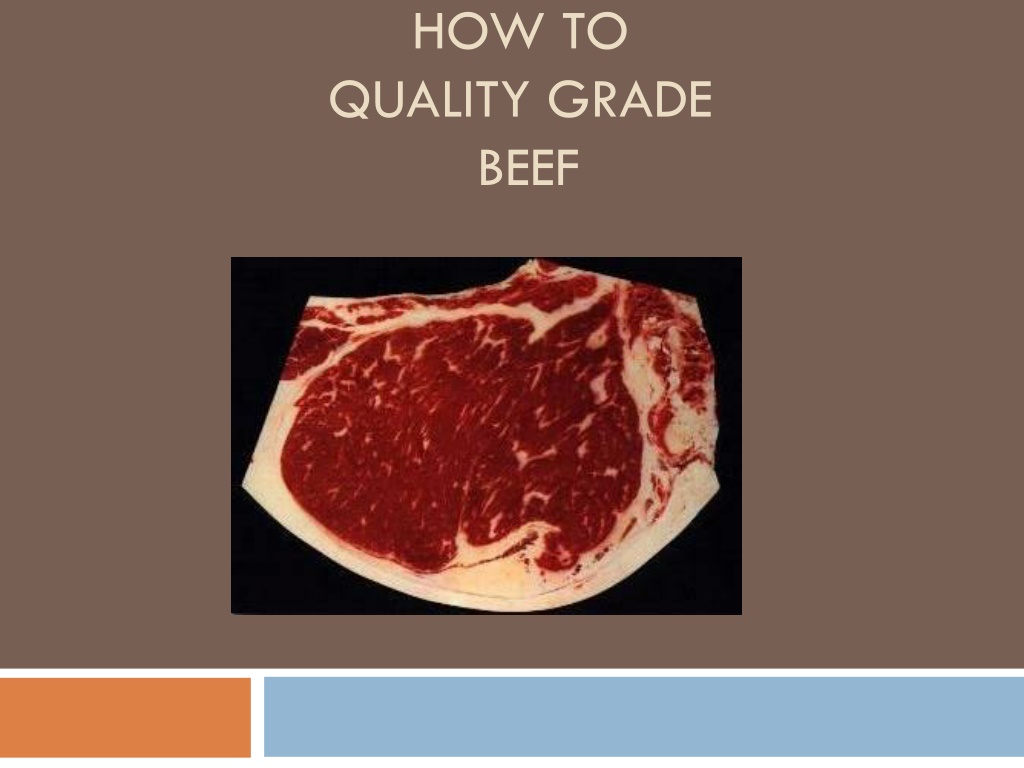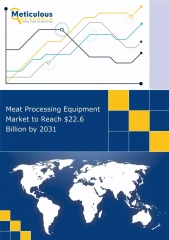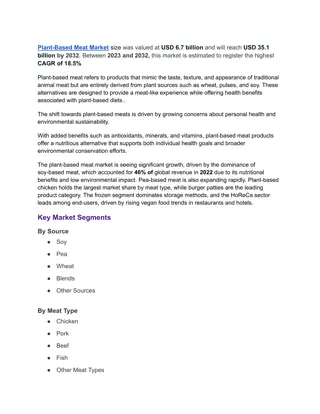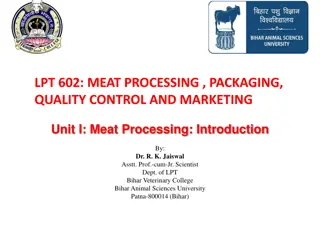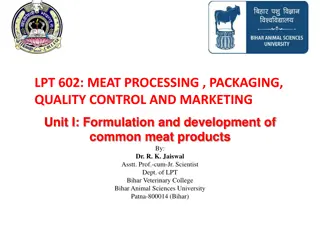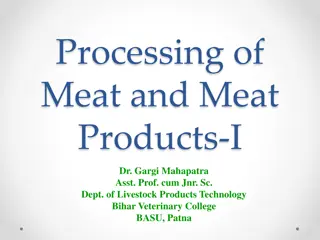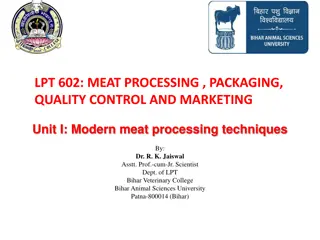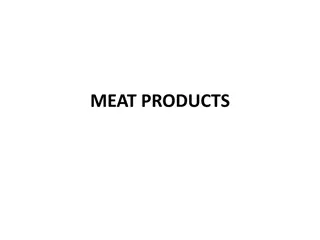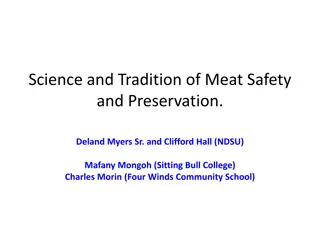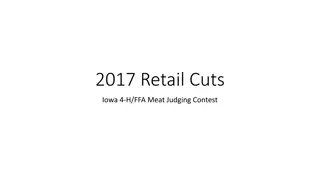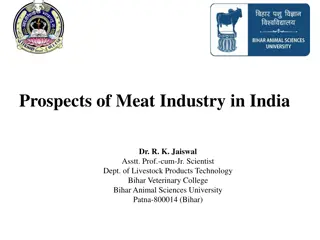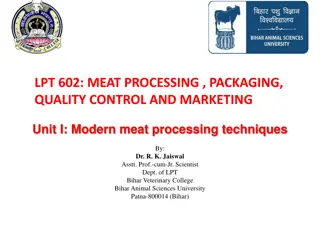Understanding Quality Grades of Meat
Quality grades of beef are based on factors like marbling, tenderness, and age of the animal. Grades range from Prime to Cutter, influencing the meat's flavor and juiciness. Lamb and poultry also have quality grades, while pork is not graded by the USDA due to its consistent tenderness. Assessing marbling is crucial in determining meat quality, with more fat leading to higher grades. The quality grade of meat can significantly impact its value and palatability when prepared correctly.
Download Presentation

Please find below an Image/Link to download the presentation.
The content on the website is provided AS IS for your information and personal use only. It may not be sold, licensed, or shared on other websites without obtaining consent from the author. Download presentation by click this link. If you encounter any issues during the download, it is possible that the publisher has removed the file from their server.
E N D
Presentation Transcript
HOW TO QUALITY GRADE BEEF
Quality Grades of Beef Meat is graded based on it quality and the amount of red meat a carcass yields. Quality Grades are a prediction of the eating quality (palatability) of properly prepared meat. Protein, vitamin and mineral content does not differ significantly between the different grades of meat but palatability does. Beef quality grades are one of the main determinants in the value of a beef carcass.
Estimating the amount of fat in the muscle The amount of fat among the muscle fibers called marbling is the biggest factor affecting quality grade. It is examined in the rib eye between the twelfth and thirteenth ribs. The more specks of fat that are visible, the higher the grade. Beef that grades prime has the highest degree of fat in the muscle. Fat is what gives meat its flavor and juiciness. Marbling does not mean it will be tender. Tenderness comes from young animals and from muscles that have not been exercised hard. That is why a rib eye steak is generally more tender than a round steak.
Quality Grades of Beef There are seven quality grades for beef from the highest to lowest. Prime Choice Select Standard Commercial Utility Cutter
Lamb Quality Grades Lamb has five quality grades. Prime Choice Good Utility Cull Good, utility and cull are seldom sold in retail stores.
Pork Pork is not given USDA quality grades as the meat is generally more uniform and tender. When buying pork, look for meat that is firm and grayish pink in color and has good marbling.
Poultry Quality Grades Grade A is the highest quality poultry and usually the only grade found in retail stores. Grade A poultry is free of defects such as bruises and broken bones, there are no tears in the skin and a good covering of fat under the skin. Grade B and Grade C are used in processed meat products. If sold in retail stores they are not usually grade identified.
Slaughter Cattle Quality Grades The amount of marbling is usually in direct relation to the amount of fat covering the Steer, The fatter the animal the more marbling it has! Prime Choice Select Standard
Quality Grades Fat is expensive to put on animals, so the higher grades of meat are usually paid premium price. Most feedlot owners want their animals to grade a low choice at slaughter. Those that feed animals to grade prime usually cater to the restaurant trade. Nationwide, only about 2% of carcasses grade Prime. Most beef bought in the grocery store is choice, although a few market chains are selling the leaner select grade as a low-fat meat.
Slaughter Cattle Quality Grades The ideal grade for slaughter cattle is; Choice Prime Select Standard
Commercial, Utility, Cutter & Canner Commercial May have marbling, but comes from a more mature animal and will lack tenderness. May be sold as ungraded or "store brand" meat. Utility, Cutter, Canner Meat from mature animals which lacks marbling. Usually only sold as ground beef or processed meat.
Factors that determine quality grade Quality Grades are determined in a two step process. Step one, calculate the age of the animals at slaughter. Step two factor in the degree of marbling. How do meat graders determine the age of the animal by looking at the carcass?
Calculating age of the animal by inspecting the bones. The age is determined by the maturity of the cartilage and bones in the carcass. As an animal ages the cartilage hardens and turns to bone. Graders inspect the rib cage and vertebrae of the carcass for the degree of bone and cartilage hardening called ossification. As the animal ages ,vertebrae in the lower end of the backbone tend to fuse or grow together. By determining the degree of ossification, graders are able to classify the animal according to its maturity.
A and B Maturity Carcass Thoracic Chine A Maturity B Maturity
ButtonsCalculating age of the animal by inspecting the bones. Animals that appear to be older than about 42 months in age cannot receive the highest two grades (Prime & Choice) because younger animals are more tender than older animals. Carcasses are separated into five maturity groups, (A,B,C,D,E) based on the estimated age of the live animal.
Carcass Maturity Based on Bone Structure Approximate live age Sacral Vertebrae Lumbar Vertebrae Thoracic Vertebrae Appearance of the ribs: Carcass maturity Distinct separation A 9 - 30 mos. No ossification No ossification Narrow and oval Nearly completely ossified Slightly wide and slightly flat B 30 - 42 mos. Completely fused Some ossification Completely ossified Slightly wide and moderately flat C 42 - 72 mos. Completely fused Partially ossified Considerable ossification (outlines of buttons are still visible) Completely ossified Moderately wide and flat D 72 - 96 mos. Completely fused Extensive ossification (outlines of buttons are barely visible) Completely ossified E > 96 mos. Completely fused Wide and flat Approximate live age Sacral Vertebrae Lumbar Vertebrae Thoracic Vertebrae Appearance of the ribs: Carcass maturity
Calculating age of the animal by color & texture of the meat. Color and texture of rib eye muscle can also be used to determine the age of the carcass. Lean color darkens and texture becomes coarser with increasing age.
Carcass Maturity Based on Meat Color & Texture Maturity A0 Lean Color Lean texture Light cherry-red Very fine Light cherry-red to slightly dark red B0 Fine Moderately light red to moderately dark red C0 Moderately fine Moderately dark red to dark red D0 Slightly coarse Dark red to very dark red E0 Coarse
Beef Maturity Groups Both bone maturity and lean maturity are used to calculate the overall maturity. Cartilage and bone maturity receives more emphasis because lean color and texture can be affected by other factors. A and B maturity levels are eligible and receive the grades of prime, choice, select, and standard, and are considered youthful carcasses. Older carcasses, with maturity levels of C, D, and E, usually from cows and bulls, receive commercial, utility, and cutter grades.
Beef Maturity Groups Maturity scores are given for each maturity group, the scores range from 0 to 90 by 10 s (10, 20, 30, 40, 50, 60, 70, 80, 90) A maturity score range from 0 to 90 and is written (A60) B maturity score range from 100 to 190 but you will find it written (B30) C maturity score range 200 to 290 and is written (C40) D Maturity score is in the 300 range E maturity score is in the 400 (You will rarely see a D or E maturity score at the meats contest)
Calculating Overall Maturity The formula for calculation overall maturity score is: Bone maturity + Lean maturity = overall maturity There is a complicated set of rules and adjustments that go along with calculating overall score. For purposes of the meats contest we don t need a precise maturity score we just need to know what the overall maturity division is (A,B,C,D or E) Just know the following guidelines.
Calculating Overall Maturity Bone Maturity A B A C A A/B Lean Maturity A A B C Overall Maturity A B A C B Remember: Bone maturity always takes precedence over lean maturity. If Bone maturity is A and Lean maturity is A then overall maturity is obviously A. If Bone Maturity is B and Lean maturity is A then the bone maturity takes precedence and the overall maturity is B. If Bone maturity is A and lean maturity is B then bone maturity take precedence and the overall maturity is A. If Bone maturity is C then the overall maturity will always be C regardless of what the lean maturity score is. If Bone maturity is A and lean maturity is C then the overall maturity would be in the middle at B.
Calculating Final Quality Grade Remember Overall Maturity + Marbling Score = USDA Quality Grade Now that we have estimated the overall maturity score at A,B,C, D, or E you can then proceed to use the marbling score to get the final USDA Quality Grade. Each degrees of marbling has been divided into high, average and low. (Except Select which has just high and low) Each degree is described based on the amount of marbling and the description has an abbreviation.
Degrees of Marbling Grade Marbling Score Abbreviation Abundant 00-100 Prime + AB Moderately Abundant 00-100 Prime MAB Slightly Abundant 00-100 Prime - SLAB Moderate 00-100 Choice + MT Modest 00-100 Choice MD Small 00-100 Choice - Sm Slight 50-100 Select + SL Slight 00-49 Select - SL Traces 34-100 Standard + TR Practically Devoid 67-100 to Traces 00-33 Standard PDTR Practically Devoid 00-66 Standard - PD
Calculating Final Quality Grade At the contest they will give you the marbling score. It will be presented using the abbreviated name and have a number beside it. (Sm 50, or Mt 60) The number represents the degree of marbling on a scale from 0 to 100. Use the maturity score and the marbling abbreviation and score to plot the final quality grade on the USDA quality Grade Chart.
Overall Maturity Score: A Marbling Score: MAB 40 Final Quality Grade= Average Prime
Overall Maturity Score: B Marbling Score: SAB 200 Final Quality Grade= Choice +
Overall Maturity Score: A Marbling Score: Mt 60 Final Quality Grade= Choice +
Overall Maturity Score: A Marbling Score: Md 50 Final Quality Grade= Choice Average
Overall Maturity Score: B Marbling Score: Sm 50 Final Quality Grade= Standard +
Overall Maturity Score: A Marbling Score: Sl 60 Final Quality Grade= Select +
FFA Meats CDE: Quality Grading Table Put an X in one space under the correct quality grade per carcass. (H=High, A=Average, L=Low ) Scoring: If you marked your card average choice for carcass # 1 you would score10 points. If you marked your card on either side of the correct answer you would score 8 points. If you marked your card two places on either side of the correct answer then you would score 5 points. Any other mark for carcass 1 would receive a zero score. Carcass Number Prime Choice Select Standard Utility H A L H A L H L H A L H A L 1 5 8 X 8 5 2 3 4 5
